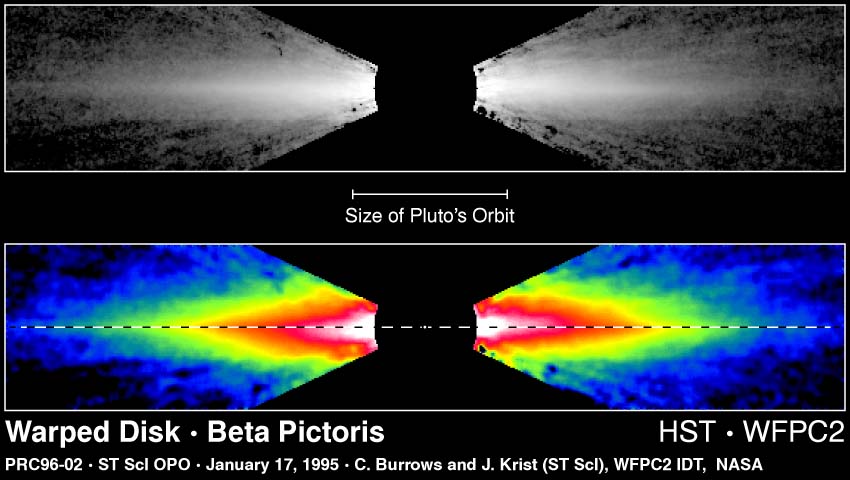
Support for the protoplanet hypothesis has been found by the detection of disk material around of stars, such as Beta Pictoris (below). Thus, the possibility of other solar systems seemed high.


An exoplanet or extrasolar planet is a planet that orbits a star other than the Sun. The first scientific detection of an exoplanet was in 1988. Since then, and as of 1 March 2017, there have been 3,586 exoplanets discovered in 2,691 planetary systems and 603 multiple planetary systems confirmed. On average, there is at least one planet per star, with a percentage having multiple planets. About 1 in 5 Sun-like stars have an "Earth-sized" planet in the habitable zone. Assuming there are 200 billion stars in the Milky Way, one can hypothesize that there are 11 billion potentially habitable Earth-sized planets in the Milky Way, rising to 40 billion if planets orbiting the numerous red dwarfs are included.
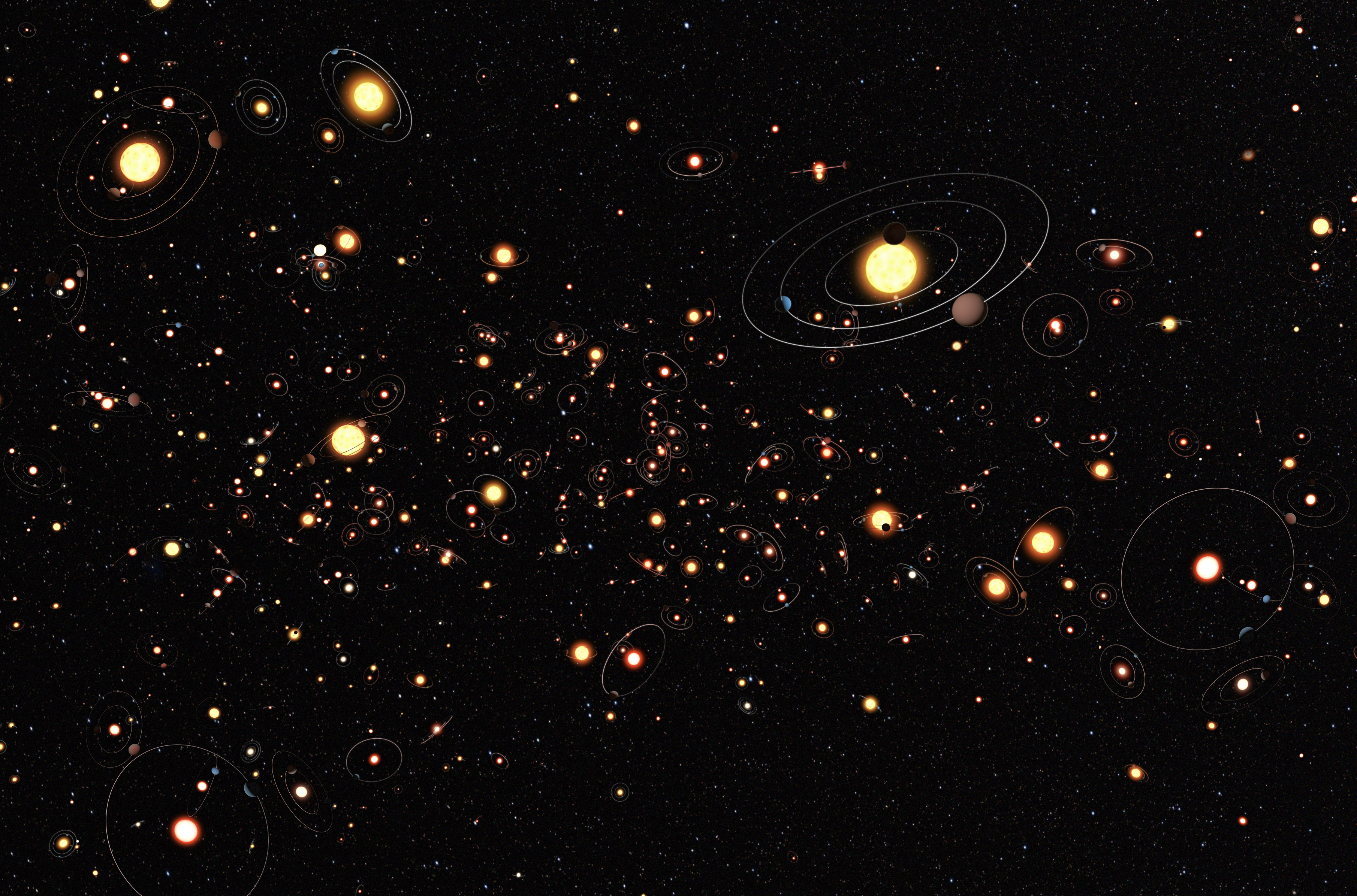
The discovery of exoplanets has intensified interest in the search for extraterrestrial life. There is special interest in planets that orbit in a star's habitable zone, where it is possible for liquid water, a prerequisite for life on Earth, to exist on the surface. The study of planetary habitability also considers a wide range of other factors in determining the suitability of a planet for hosting life.
Doppler Detection:
Doppler spectroscopy is used to detect the periodic velocity shift of the stellar spectrum caused by an orbiting giant planet. This method is also referred to as the radial velocity method. From ground-based observatories, spectroscopists can measure Doppler shifts greater than 3 m/sec due to the reflex motion of the star This corresponds to a minimum detectable mass of 33 Earth masses for a planet at 1 AU from a one solar-mass star.
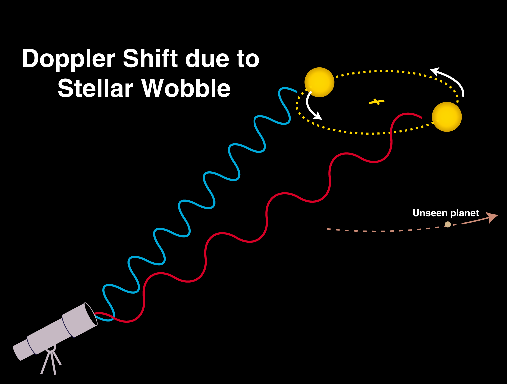
All stars exhibit some Doppler shift because all stars are moving in the gravitational field of our Galaxy. But the stars that move toward us, then away from us, then toward us again wobbling with periodic motion are gravitationally bound to another object. The magnitude of this changing velocity, together with the period of the motion, reveals the mass of an invisible companion to a visible star. Our Sun moves with a speed of about 12 meters/sec due to the most massive planet in our Solar System, Jupiter. The periodicity of the Sun's motion is the same as the orbital period of Jupiter: one cycle takes about twelve years.
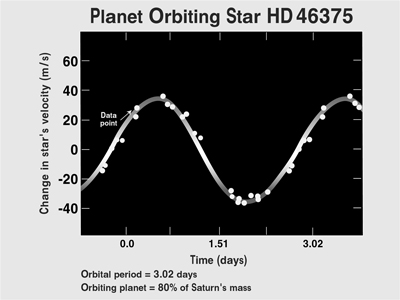
Transit Method:
A more direct measure occurs is a planet transits across the front of a star, as happened with HD 209458, a distant planet passing in front of its star, providing direct and independent confirmation of the existence of extrasolar planets.

Astronomers predicted the planet would cross the face of the star if the planet's orbital plane were lucky enough to carry it between Earth and the star. Until now, none of the 18 other extrasolar planets discovered has had its orbital plane oriented edge-on to Earth so that the planet could be seen to transit the star, nor have any of the other planets discovered by other researchers. However, on Nov. 7, 1999 an automatic telescope observed a 1.7 percent dip in the star's brightness.

With the orbital plane of the planet known, the astronomers for the first time could determine precisely the mass of the planet and, from the size of the planet measured during transit, its density. Interestingly, while the planet's mass is only 63 percent of Jupiter's mass, its radius is 60 percent bigger than that of Jupiter. This fits with theories that predict a bloated planet when, as here, the planet is very close to the star.
Direct Imaging:
Planets are extremely faint light sources compared to stars, and what little light comes from them tends to be lost in the glare from their parent star. So in general, it is very difficult to detect and resolve them directly from their host star. Planets orbiting far enough from stars to be resolved reflect very little starlight, so planets are detected through their thermal emission instead. It is easier to obtain images when the star system is relatively near to the Sun, and when the planet is especially large (considerably larger than Jupiter), widely separated from its parent star, and hot so that it emits intense infrared radiation; images have then been made in the infrared, where the planet is brighter than it is at visible wavelengths. Coronagraphs are used to block light from the star, while leaving the planet visible. Direct imaging of an Earth-like exoplanet requires extreme optothermal stability.


Four planets were directly observed orbiting HR 8799, whose masses are approximately ten, ten, and seven times that of Jupiter.
Characteristics of Exoplanet systems:
Initially, most known exoplanets were massive planets that orbited very close to their parent stars. Astronomers were surprised by these "hot Jupiters", because theories of planetary formation had indicated that giant planets should only form at large distances from stars. But eventually more planets of other sorts were found, and it is now clear that hot Jupiters make up the minority of exoplanets. In 1999, Upsilon Andromedae became the first main-sequence star known to have multiple planets. Kepler-16 contains the first discovered planet that orbits around a binary main-sequence star system.
On 26 February 2014, NASA announced the discovery of 715 newly verified exoplanets around 305 stars by the Kepler Space Telescope. These exoplanets were checked using a statistical technique called "verification by multiplicity". Prior to these results, most confirmed planets were gas giants comparable in size to Jupiter or larger as they are more easily detected, but the Kepler planets are mostly between the size of Neptune and the size of Earth.
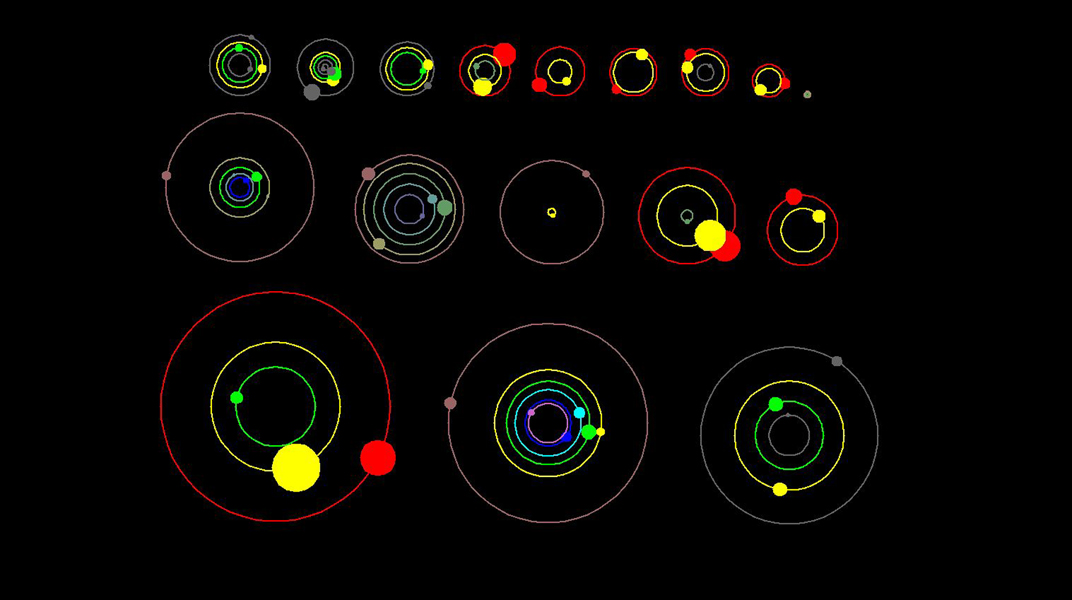
Some studies suggest that there is at least one planet on average per star. This would suggest that, like the Solar System, most stars have planets (or exoplanets). However, the proportion of stars is uncertain because not all planets can yet be detected. The radial-velocity method and the transit method (which between them are responsible for the vast majority of detections) are most sensitive to large planets in small orbits. Thus, many known exoplanets are "hot Jupiters": planets of Jovian mass or larger in very small orbits with periods of only a few days. A 2005 survey of radial-velocity-detected planets found that about 1.2% of Sun-like stars have a hot Jupiter, where "Sun-like star" refers to any main-sequence star of spectral classes late-F, G, or early-K without a close stellar companion. This 1.2% is more than double the frequency of hot jupiters detected by the Kepler spacecraft, which may be because the Kepler field of view covers a different region of the Milky Way where the metallicity of stars is different. It is further estimated that 3% to 4.5% of Sun-like stars possess a giant planet with an orbital period of 100 days or less, where "giant planet" means a planet of at least 30 Earth masses.
It is known that small planets (of roughly Earth-like mass or somewhat larger) are more common than giant planets. It also appears that there are more planets in large orbits than in small orbits. Based on this, it is estimated that perhaps 20% of Sun-like stars have at least one giant planet, whereas at least 40% may have planets of lower mass. A 2012 study of gravitational microlensing data collected between 2002 and 2007 concludes the proportion of stars with planets is much higher and estimates an average of 1.6 planets orbiting between 0.510 AU per star in the Milky Way. The authors of this study conclude that "stars are orbited by planets as a rule, rather than the exception".
Whatever the proportion of stars with planets, the total number of exoplanets must be very large. Because the Milky Way has at least 200 billion stars, it must also contain tens or hundreds of billions of planets.
Hot Jupiter's:
Hot Jupiters (also called roaster planets, epistellar jovians, pegasids or pegasean planets) are a class of exoplanets that are inferred to be physically similar to Jupiter but that have very short orbital radii with semi-major axes from 0.015 to 0.05 astronomical units. The close proximity to their stars and high surface temperatures resulted in the moniker "hot Jupiters".
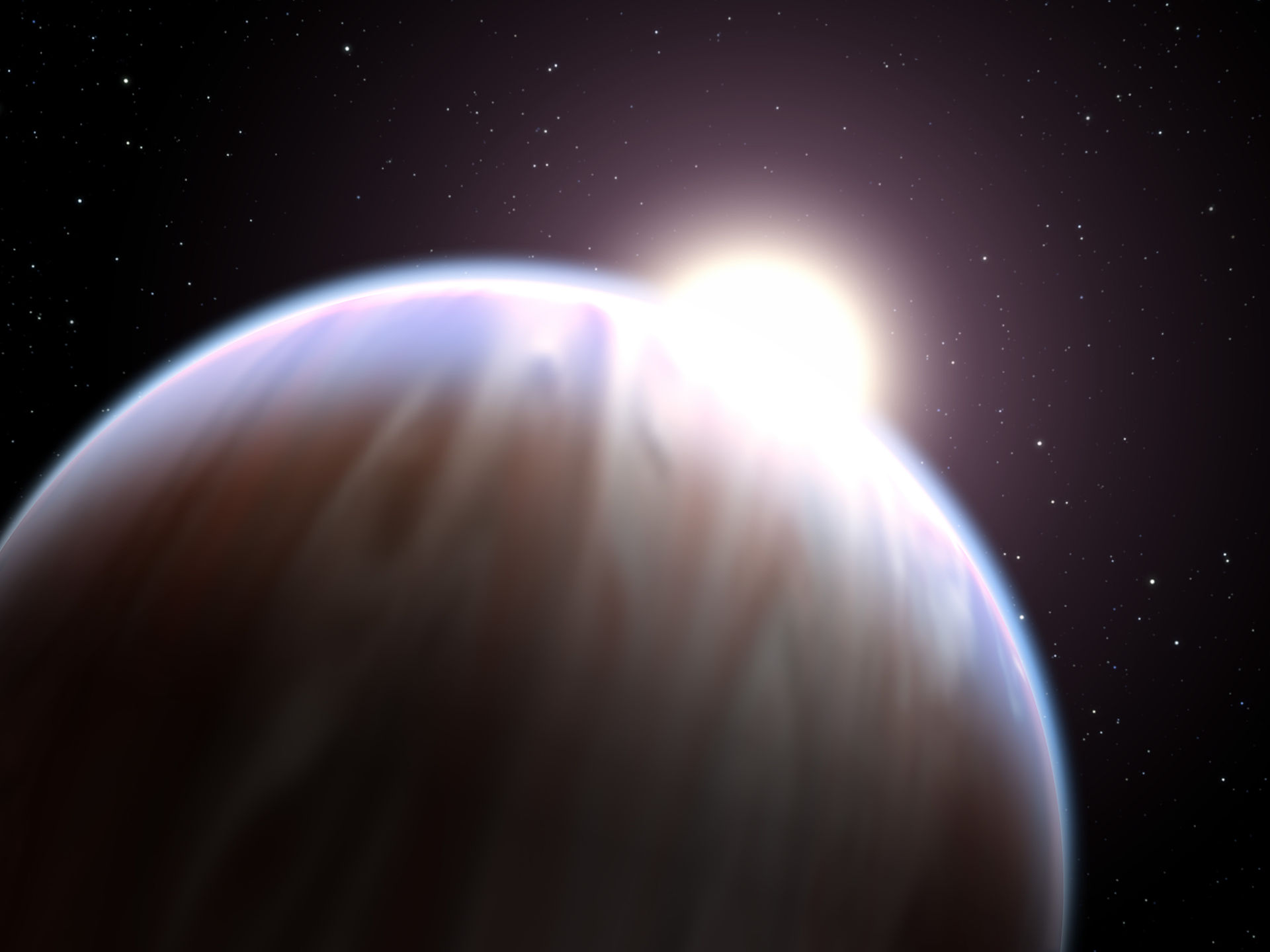
Hot Jupiters are the easiest extrasolar planets to detect via the radial-velocity method, because the oscillations they induce in their parent stars' motion are relatively large and rapid compared to those of other known types of planets. One of the best-known hot Jupiters is 51 Pegasi b. Discovered in 1995, it was the first extrasolar planet found orbiting a Sun-like star. 51 Pegasi b has an orbital period of about 4 days.
Though there is diversity among hot Jupiters, they do share some common properties:
Super Earth's:
A super-Earth is an extrasolar planet with a mass higher than Earth's, but substantially below the masses of the Solar System's ice giants, Uranus and Neptune, which contain 15 and 17 Earth masses respectively. The term super-Earth refers only to the mass of the planet, and so does not imply anything about the surface conditions or habitability. The alternative term gas dwarfs may be more accurate for those at the higher end of the mass scale, as suggested by MIT professor Sara Seager, although mini-Neptunes is a more common term.

In general, super-Earths are defined exclusively by their masses, and the term does not imply temperatures, compositions, orbital properties, habitability, or environments. While sources generally agree on an upper bound of 10 Earth masses (~69% of the mass of Uranus, which is the Solar System's gas giant with the least mass), the lower bound varies from 1 or 1.9 to 5, with various other definitions appearing in the popular media. The term "super-Earth" is also used by astronomers to refer to planets bigger than Earth-like planets (from 0.8 to 1.25 Earth-radii), but smaller than mini-Neptunes (from 2 to 4 Earth-radii). This definition was made by the Kepler Mission. Some authors further suggest that the term be limited to planets without a significant atmosphere, or planets that have not just atmospheres but also solid surfaces or oceans with a sharp boundary between liquid and atmosphere, which the four giant planets in the Solar System do not have. Planets above 10 Earth masses are termed massive solid planets/mega-Earths or gas giant planets depending on whether they are mostly rock and ice or mostly gas.

Due to the larger mass of super-Earths, their physical characteristics may differ from Earth's; theoretical models for super-Earths provide four possible main compositions according to their density: low-density super-Earths are inferred to be composed mainly of hydrogen and helium (mini-Neptunes); super-Earths of intermediate density are inferred to either have water as a major constituent (ocean planets), or have a denser core enshrouded with an extended gaseous envelope (gas dwarf or sub-Neptune). A super-Earth of high density is believed to be rocky and/or metallic, like Earth and the other terrestrial planets of the Solar System. A super-Earth's interior could be undifferentiated, partially differentiated, or completely differentiated into layers of different composition.
If a super-Earth is detectable by both the radial-velocity and the transit methods, then both its mass and its radius can be determined; thus its average bulk density can be calculated. The actual empirical observations are giving similar results as theoretical models, as it's found that planets larger than approximately 1.6 Earth-radius (more massive than approximately 6 Earth-masses) contain significant fractions of volatiles or H/He gas (such planets appear to have a diversity of compositions that is not well-explained by a single mass-radius relation as that found in rocky planets). After measuring 65 super-Earths smaller than 4 Earth-radii, the empirical data points out that Gas Dwarves would be the most usual composition: there is a trend where planets with radii up to 1.5 Earth-radii increase in density with increasing radius, but above 1.5 radii the average planet density rapidly decreases with increasing radius, indicating that these planets have a large fraction of volatiles by volume overlying a rocky core. Similar results are confirmed by other studies.
Further theoretical work by Valencia and others suggests that super-Earths would be more geologically active than Earth, with more vigorous plate tectonics due to thinner plates under more stress. In fact, their models suggested that Earth was itself a "borderline" case, just barely large enough to sustain plate tectonics. However, other studies determine that strong convection currents in the mantle acting on strong gravity would make the crust stronger and thus inhibit plate tectonics. The planet's surface would be too strong for the forces of magma to break the crust into plates.

The new research suggests that the rocky centres of super-Earths are unlikely to evolve into terrestrial rocky planets like the inner planets of the Solar System because they appear to hold on to their large atmospheres. Rather than evolving to a planet composed mainly of rock with a thin atmosphere, the small rocky core remains engulfed by its large hydrogen-rich envelope.
Theoretical models show that Hot Jupiters and Hot Neptunes can evolve by hydrodynamic loss of their atmospheres to Mini-Neptunes (as it could be the Super-Earth GJ 1214 b), or even to rocky planets known as chthonian planets (after migrating towards the proximity of their parent star). The amount of the outermost layers that is lost depends on the size and the material of the planet and the distance from the star. In a typical system a gas giant orbiting 0.02 AU around its parent star loses 5-7% of its mass during its lifetime, but orbiting closer than 0.015 AU can mean evaporation of the whole planet except for its core.
The low densities inferred from observations imply that a fraction of the super-Earth population has substantial H/He envelopes, which may have been even more massive soon after formation. Therefore, contrary to the terrestrial planets of the solar system, these super-Earths must have formed during the gas-phase of their progenitor protoplanetary disk.
According to one hypothesis, super-Earths of about two Earth masses may be conducive to life. The higher surface gravity would lead to a thicker atmosphere, increased surface erosion and hence a flatter topography. The end result could be an "archipelago planet" of shallow oceans dotted with island chains ideally suited for biodiversity. A more massive planet of two Earth masses would also retain more heat within its interior from its initial formation much longer, sustaining plate tectonics (which is vital for regulating the carbon cycle and hence the climate) for longer. The thicker atmosphere and stronger magnetic field would also shield life on the surface against harmful cosmic rays.

|
|

|